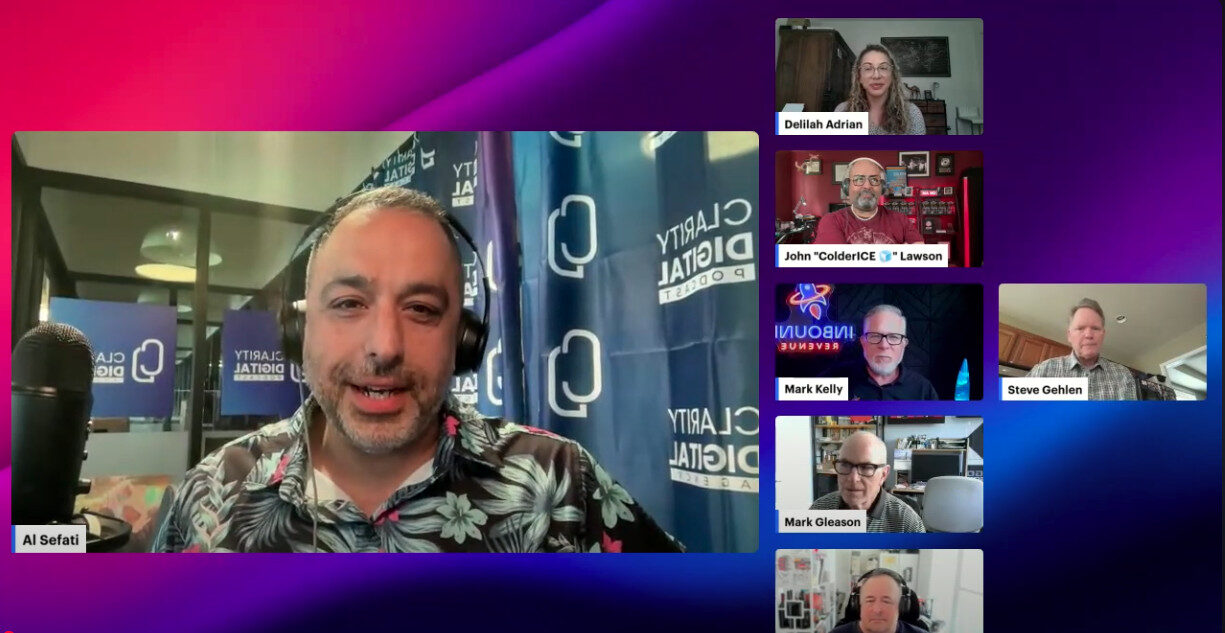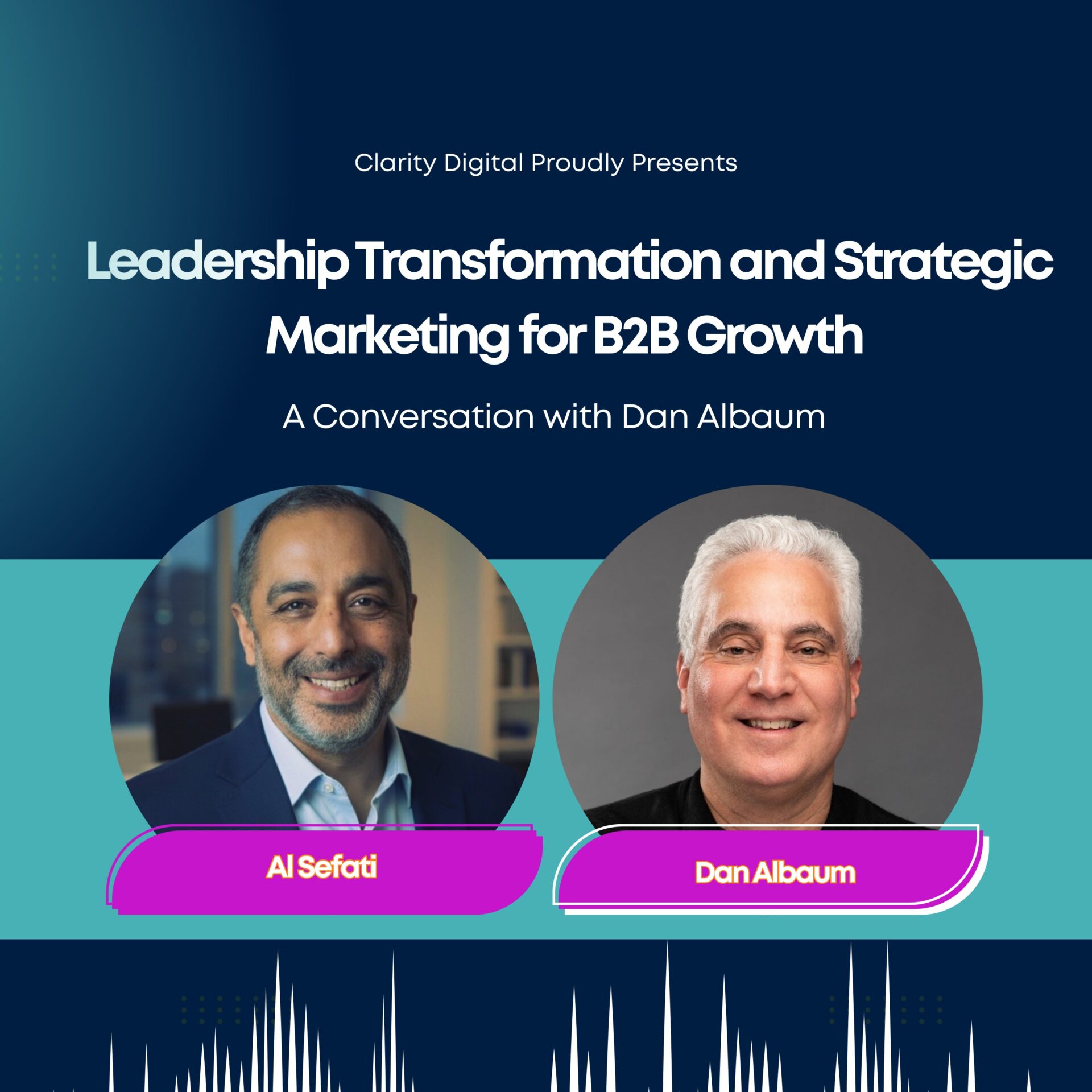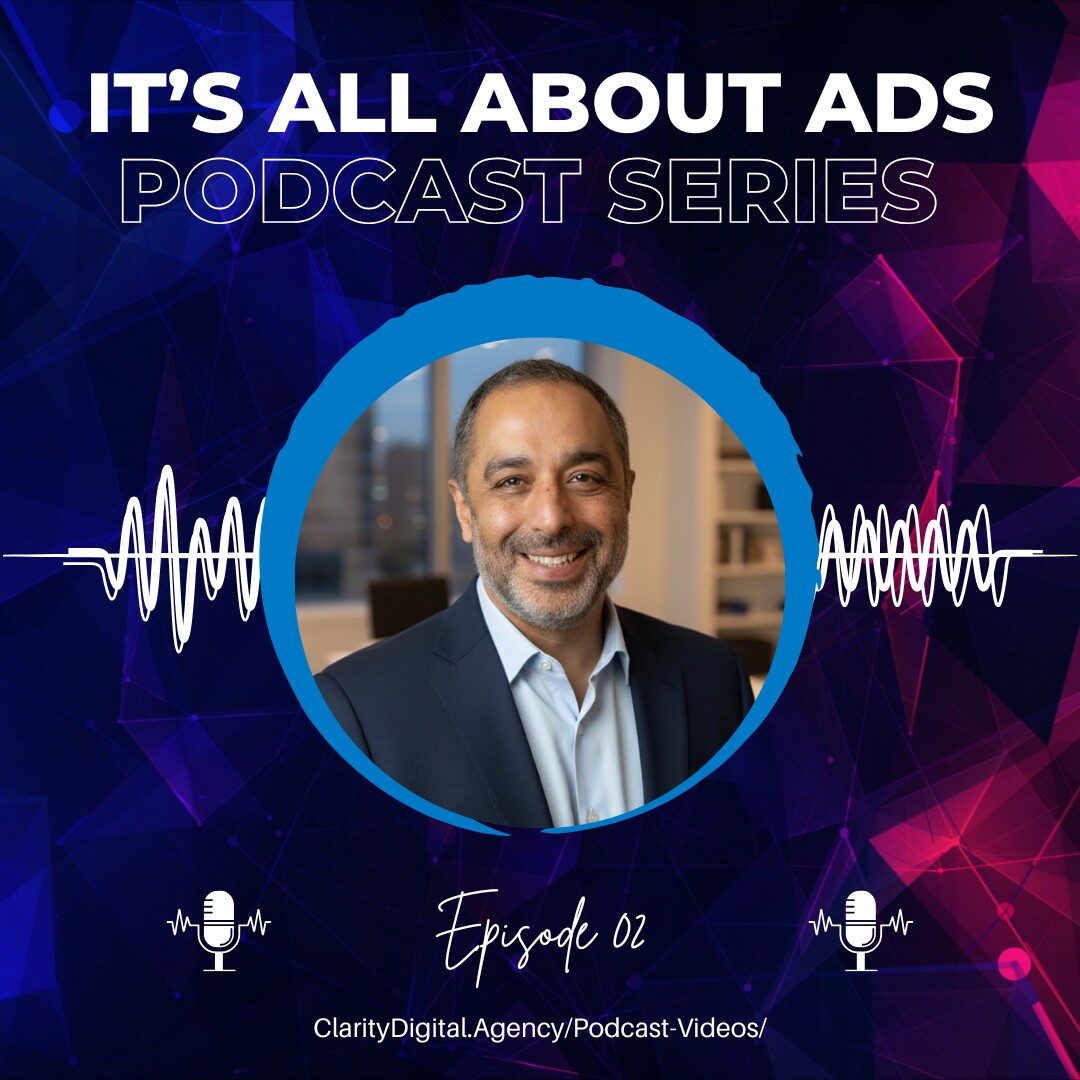Marketing Munch & Masterminds: AI Takes Center Stage!
In April 2025, Clarity Digital Agency hosted the first-ever Marketing Leadership Roundtable—a candid, in-depth discussion between marketers, consultants, agency leaders, and digital pioneers. The goal? To unpack the evolving state of marketing leadership and the role of artificial intelligence in our daily practices, team management, client expectations, and strategic outlook.
This post recaps that conversation and highlights key takeaways from the guests who joined: Delilah from Black Box LG, John Lawson of Colder Ice Media, Mark Kelly of Inbound Revenue, Mark Gleason (former MeridianLink), Mark Kinski of Control Media, and Steve, Director of Digital Marketing & E-commerce at Wilco.
Diverse Voices, One Common Thread
The guests represented a mix of agency owners, B2B and B2C strategists, AI consultants, and marketing technologists. Some were Clarity Digital clients, others collaborators, and all shared a common passion for modern marketing.
Steve shared a blend of B2C and nonprofit experience, with strong insights into digital team leadership, e-commerce, and the value of professional development.
Delilah brought a B2B enterprise perspective with demand gen roots.
John Lawson, a long-time ecommerce expert and AI consultant, challenged the group to think more futuristically.
Mark Kelly represented the agency-side PPC world, with deep expertise in Google Ads, Facebook Ads, and local services.
Mark Gleason, who worked with Al at MeridianLink, provided firsthand examples of AI’s limitations in data analysis.
Mark Kinski offered perspectives from the consulting and go-to-market trenches.
Here’s a glimpse into the rich conversation:
- Real-World Applications: The panel showcased concrete examples of how AI is revolutionizing marketing, from automated content creation and predictive analytics to targeted advertising and customer segmentation.
- Workflow Streamlining: We explored the tools and technologies that are simplifying marketing processes, freeing up marketers to focus on strategic initiatives and creative endeavors.
- Personalized Experiences: The discussion highlighted how AI enables hyper-personalization, allowing brands to deliver tailored experiences that resonate with individual customers.
- Ethical Considerations: We addressed the critical ethical implications of AI in marketing, emphasizing the importance of responsible data usage and transparency.
- Future Trends: The panel shared their predictions for the future of AI in marketing, offering a glimpse into the emerging technologies and strategies that will shape the industry.
This session was packed with practical advice and forward-thinking insights, making it a must-watch for any marketing professional. Whether you’re a seasoned leader or just beginning your marketing journey, you’ll find valuable takeaways in our video.
Don’t miss out! Watch the full session:
Summary:
The group quickly aligned around one reality: We’re still in the early innings of AI adoption. While generative AI has gained massive traction over the past two years, few companies are using it holistically or strategically. The tools are fragmented. The outputs are inconsistent. And while there’s a lot of excitement, there’s also confusion.
Steve shared how his team started with Grammarly—a tool that had AI long before it became a buzzword. This incremental approach (starting with familiar tools) helped create buy-in without overwhelming the team. Grammarly then expanded into GrammarlyGO (its generative product), which Steve’s team used to maintain brand consistency across campaigns.
Others, like Mark Gleason, added caution: “There’s a misconception that AI can fully automate digital marketing. It can’t. It’s a tool—not a brain in a box.” He warned against overreliance on AI for things like competitive analysis or website auditing, noting that many tools produce as much bad data as good data.
AI in Practice: Strategy vs. Tactics
A common thread emerged—AI is excellent at saving time but still requires human judgment. As Delilah noted, marketers must guide AI, not surrender to it. Prompting, re-prompting, and editing are essential parts of the workflow. It’s not “plug-and-play.”
Mark Kinski agreed, comparing today’s AI stack to a disjointed team. “Each tool operates in its own silo. Until all these models and datasets connect and work together under a shared intelligence layer, marketers will still need to stitch things together manually.”
Several guests pointed out that AI is best suited for repetitive or low-leverage tasks—drafting, summarizing, or pulling reports—freeing humans to focus on high-impact creative, strategic, and analytical work.
Mark Kelly added that while AI tools like ChatGPT can write well, they still hallucinate or over-simplify complex topics, especially technical ones. “It’s replaced some Fiverr jobs for us, sure—but I wouldn’t trust it for client-facing strategic content without heavy editing.”
AI in Paid Ads: Still Not There
As someone who’s spent decades managing Google Ads, Mark Kelly reminded the group that even Google’s built-in automation is far from perfect. “Smart campaigns and Performance Max often make poor decisions unless you burn through budget to train them properly.”
Facebook, he added, pushes users into AI-optimized audience targeting, but the results often underperform custom-built campaigns. That mirrors Clarity Digital’s experience as well: AI needs structure, strong inputs, and human review to perform reliably.
B2B vs. B2C AI Use Cases
The conversation shifted toward segmentation: Is AI progressing differently across B2B vs. B2C?
Delilah raised the question, pointing out that B2C is broader and typically more automated. B2B, however, involves multiple personas, longer sales cycles, and more nuanced messaging.
Mark Gleason argued that B2B could actually benefit more from AI when it comes to identifying decision-makers and crafting tailored value propositions. “No business buys unless it saves or makes money,” he said. “AI can help model the ROI, even if it’s rough—giving sales teams better talking points and tools.”
Steve agreed. “Most of the sales emails I get now are way more relevant than they used to be. That’s AI. The targeting is better. But I still ignore 99% of them because I don’t have time. That’s the bottleneck now—not awareness, but attention.”
That spurred another insight: AI might one day curate the flood of outreach for the recipient. Imagine an AI that filters your inbox and tells you, “Hey, this sales email is worth reading.” That would be a breakthrough.
Content, Branding & Thought Leadership: More Important Than Ever
A key takeaway from the discussion was the renewed importance of content quality and brand consistency.
Mark Kelly explained how he uses educational videos—technical Google Ads walkthroughs and case studies—to build credibility and generate leads. “People find me through YouTube, and by the time they reach out, they’re pre-sold.”
That’s a crucial insight in an AI-driven world: Content still needs to demonstrate authority, differentiate the brand, and connect with humans. B2B buyers in particular crave substance, not fluff. As Al pointed out, removing technical blogs from one client’s website led to a dramatic drop in SEO traffic and leads. The “marketing-only” content strategy backfired.
The Future: From Human Touch to Agent-to-Agent Transactions?
Al floated a provocative scenario: What happens when machines start buying from machines?
Case in point: Alexa reordering coffee without any interaction. It remembered the brand, quantity, and delivery timing—executing a transaction that traditionally would’ve required a landing page, CTA, and marketing funnel.
As John Lawson warned, “We’re at Pong. In a few years, we’ll be at PlayStation 6. The transformation will be exponential, not linear.”
Steve echoed that prediction but added nuance. “Consumer behavior evolves slowly. We’re still at 16–20% ecommerce penetration. People still like in-store shopping. AI adoption will be uneven across industries, demographics, and product types.”
But the potential is clear: In the near future, marketers may not be optimizing for human search queries, but rather for LLM prompts or AI agents. The goal will shift from ranking on Google to being referenced in ChatGPT or Perplexity answers. That means branding, trust signals, and early-funnel influence will matter even more.
Marketing Leadership in the AI Era
The conversation wrapped with thoughts on how leaders should guide their teams through this transformation.
Steve suggested the incremental adoption model: Start with easy-to-use tools like Grammarly or Notion AI, provide team training, and build guardrails. Don’t force change, but create space for experimentation.
John reminded everyone not to focus on what AI “can’t do” today. “Focus on what it can do. The tools are evolving fast. The real value is in saving time, reducing mundane tasks, and redirecting energy toward what makes money.”
Al noted that some team members overuse AI, others underuse it. Leadership means finding balance—encouraging strategic use, while reinforcing the importance of originality, critical thinking, and brand alignment.
Mark Gleason emphasized attribution as a major challenge ahead. “It’s never been perfect, but it’s getting worse. As AI-generated touchpoints rise and traditional metrics vanish, we’ll need new ways to prove ROI—especially in B2B.”
Final Thought: Human Insight Still Wins
One of the most valuable observations came from John, who reflected on the resurgence of newsletters and podcasts.
“People are overwhelmed with content,” he said. “That’s why they turn to trusted humans—to tell them what’s worth paying attention to. AI can generate content. But humans help curate it. That’s not changing anytime soon.”
The conversation closed with a reflection on what’s next—for marketing, for leadership, and for Clarity Digital’s own podcast and community.
Summary: Key Takeaways from the Roundtable
- AI is a tool, not a solution — Marketing leaders must guide its usage and avoid overreliance.
- Adoption is uneven — Some teams overuse AI, others ignore it. Leadership is about balance.
- Thought leadership matters more — Especially in B2B, where buying cycles are longer and personas are complex.
- The human touch still drives results — From content to sales to creative strategy, people still want to hear from people.
- Marketing attribution is breaking — And AI is both a culprit and a potential solution.
- Prepare for agent-to-agent commerce — The way products are discovered, evaluated, and purchased is changing—fast.
- Leaders need peer support — Collaboration, learning, and transparency between marketers will be crucial going forward.
Contact Clarity Digital Agency Today to Evaluate Your AI or Marketing Strategy
As the marketing landscape evolves faster than ever, one truth remains: Strategy, leadership, and clear thinking will always rise above the noise. AI is no longer optional—but how it’s implemented makes all the difference.
At Clarity Digital Agency, we’re staying ahead by combining strategic vision with AI-powered tools, creative thinking, and a focus on what really matters: performance, brand strength, and authentic marketing.
Have questions or want to dive deeper into your marketing strategy or AI readiness?
Get in touch with Clarity Digital Agency to schedule a free strategy session. Let’s figure out what’s next—together.




